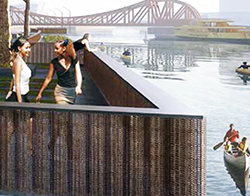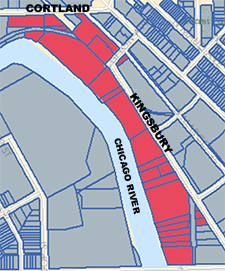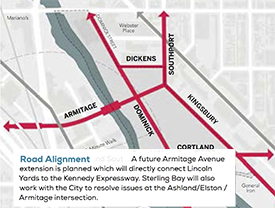Elements of the proposed Lincoln Yards complex, which shifted repeatedly prior to its City Council approval this year, continue to change.
Among the recent revelations by the city of Chicago:
- Developer Sterling Bay will own parts of the Chicago River shoreline, which elsewhere is city property.
- Taxpayers will foot the bill for interest on Sterling Bay's construction loans.
- To figure when it has enough property taxes to reimburse Sterling Bay's construction costs, the city will use the expected value of property not fully assessed.
Background
Lincoln Yards' 14.5 million square feet of residences, offices, and retail will straddle the Chicago River's North Branch, north of North Avenue and south of Webster Street. In March of this year, Chicago's City Council approved the rezoning needed for Sterling Bay to construct the mixed-use buildings planned for Lincoln Yards.
In April, the City Council also approved the Cortland and Chicago River Redevelopment Project Area, otherwise known as the Cortland/Chicago River tax-increment financing (TIF) district.
The TIF district would encircle Lincoln Yards. The city plans that the TIF district, about twice the size of the complex, will pay for the public infrastructure that Lincoln Yards would need—and which Sterling Bay has agreed to build.
The council's TIF approval came in the form of a half-dozen ordinances that codify tax-increment financing in the district. Shortly after council approval, the city released new versions of two of the ordinances:
- SO2019-2162, dated April 3 but released publicly on April 18, contains the city's redevelopment area project and plan (RAPP) for the TIF district. The RAPP identifies the city's development goals for the district, and describes how achieving those goals will grow the assessed value of property—which the city can then capture in property taxes. (Find a line-by-line comparison of the previous and current RAPPs here.)
- SO2019-2583, dated April 9, contains the redevelopment agreement (RDA) between the city and Sterling Bay for construction of about a dozen "infrastructure components"—mostly streets and bridges—in the TIF district. (Find a line-by-line comparison of the previous and current RDAs here.)
Over the last year, Lincoln Yards critics have objected to the pace and frequency of changes to the size, scope, and funding details of Lincoln Yards and the TIF district. The magnitude of these changes, they said, was a good reason to wait on final council approvals. City officials disagreed.
The latest changes
Here are changes to Lincoln Yards construction, and its financing, gleaned from the current versions of the Lincoln Yards RDA and the Cortland/Chicago River TIF district RAPP:
IOU vs. cash: The previous RDA had provided that the city reimburse Sterling Bay for its infrastructure construction costs via the issuance of city debt notes—financial instruments (essentially IOUs with interest) that Sterling Bay could sell on the financial market or redeem upon maturity. The current RDA provides that the city may instead pay cash to Sterling Bay.
Financing costs: Both the previous and current RDAs identify the cost of the "TIF-Funded Infrastructure Components Improvements" as $487,300,000. But the current RDA explicitly states that TIF will also pay for financing costs incurred by both the city and Sterling Bay. While the RDA doesn't limit the financing costs, it does show that TIF will pay for Sterling Bay's "Lender Financing" of $45,885,000, which corresponds exactly to the amount added to the "Guaranteed Maximum Price" of improvements to the Chicago River's shoreline walls. Separately, the Chicago Dept. of Planning and Development estimated that financing costs, including interest the city pays on its debt notes, could reach $200,000,000 "minimum."

Artist's conception of a proposed river wall section.
Source: Sterling Bay.
Separate river walls: The previous RDA identified river wall improvements as a single project with a stated budget of $45,885,000. The current RDA identifies the east/north wall improvement and south/west wall improvement as separate projects. The stated budget for the east/north wall is $41,860,000, and $49,910,000 for the south/west wall.
River wall costs: Both the previous and current RDAs provide a list of the infrastructure components' "TIF Eligible Costs." The previous RDA showed that 100 percent of each component's "Project Budget Amount" is eligible to be paid for by TIF. The current RDA, however, shows that only 50 percent of each of the two river wall components is eligible to be paid for by TIF.
For the total river wall expense, the current RDA doubles the budget amount (which it re-labels "Guaranteed Maximum Price") from $45,885,000 to $91,770,000. The added $45,885,000 corresponds exactly to the amount of Sterling Bay's "Lender Financing" included in the current (but not the previous) RDA.
Collateral assignment: The current RDA lets Sterling Bay make a "collateral assignment" of any city note, meaning that it can transfer the financial instrument to its lender as security on a loan—and, once Sterling Bay has paid off the loan, it can have the instrument transferred back.
First city note: The previous RDA had based the city's issuance of the first city note on completion of "at least 17 percent of the Project," which city officials said represented work on a realignment of the Elston/Ashland intersection. The current RDA instead bases issuance of the first city note on completion of the Dominick Street Extension and Bridge.
Dominick St. project: The previous RDA identified a single Dominick Street Extension and Bridge project with a stated budget of $115,115,000. The current RDA reduces that budget to $107,870,000, and identifies a separate "Dominick St. Final Condition" (budgeted at $7,245,000) that comprises "additional street surfacing and elements to create a shared street condition from Armitage to Cortland." The Final Condition is scheduled to finish one year before the completion of the Dominick St. Extension.
Anticipated taxes: According to both the previous and current RDAs, the city will issue notes contingent on a minimum level of available incremental property taxes in the TIF district. The current RDA lets the calculation of that minimum level include "anticipated" property taxes for newly constructed buildings for which a standard assessment hasn't yet been done.
"Guaranteed Maximum Price": The previous RDA had established a "Guaranteed Maximum Price" for each city infrastructure component that Sterling Bay builds. The current RDA shows those prices as "estimated," and may be "modified" to "be higher or lower"—making the "maximum price" not so "guaranteed." But, said planning department spokesman Pete Strazzabosco via e-mail, "in no case may the total amount of TIF provided exceed" $487,300,000.
The current RDA also requires Sterling Bay to get city approval if it increases the price of a component by more than one percent; in the previous RDA, it was ten percent. Finally, the current RDA lets Sterling Bay "reallocate the maximum amount of TIF-Eligible Costs among different Infrastructure Components."

Properties (in red) excluded from TIF funding of
infrastructure components. Sources: city of
Chicago, Cook County.
Infrastructure ownership: The current RDA lets Sterling Bay retain ownership of the river wall sections that it improves—unlike the other infrastructure components, which "shall be owned by the City or other governmental or quasi-governmental entity."
Property transfer: The current RDA lets Sterling Bay "sell, assign or transfer a portion" of property in the TIF district to its lenders and/or investment partners "without the City's prior approval."
Excluded properties: The current RDA identifies 28 properties on the east side of the TIF district from which incremental property taxes will not pay for infrastructure components. All but five of these "Excluded PINs" are owned or controlled by General Iron Industries. The other five:
- 1110 W. North Ave., a city-owned vacant lot on the river on the north side of the North Ave. bridge
- A Commonwealth Edison-owned lot at 1716 N. Kingsbury St.
- Privately-owned commercial buildings at 1748, 1760, and 1800 N. Kingsbury St.
In separate ordinances, the city shifted dozens of properties from other TIF districts to the Cortland/Chicago River TIF district: 60 properties from the North Branch (North) district, and 116 from the North Branch (South) district.
Completion date: The previous RDA had stipulated that Sterling Bay must finish each city infrastructure component "on or before the Completion Date" shown in the RDA. While the current RDA also shows these dates, it says that Sterling Bay must finish each one only "to the extent" that the developer has "commenced" it—meaning that if it hasn't started on time, it doesn't have to finish on time, either. (Although, Strazzabosco said via e-mail, delay "approval is not guaranteed.")

An image from Sterling Bay's January 2019 Lincoln Yards
"master plan" shows its proposed Armitage Ave. extension
west of the river to I-94. Source: Sterling Bay.
Missing parts: For each of 13 (previously 14) city infrastructure components, the previous RDA had named all the smaller parts that comprised it, and the start/end dates for each of these parts. (E.g., the Dominick St. extension listed four separate parts: an extension in Lincoln Yards North, an extension in Lincoln Yards South, a bridge, and a new section from North Ave. to Concord Place.) All those parts, and their timelines, don't appear in the current RDA.
One potentially challenging part that appears in the previous RDA but not in the current RDA: For the Armitage Ave. extension, the component list had shown a new roadway west of the river running about 350 feet to Mendell Street. That would cut through a riverside property currently owned by concrete company Ozinga Ready Mix, which has not announced plans to move. Asked via e-mail how the city expects the roadway to be built on Ozinga's property, the planning department's Strazzabosco answered indirectly—saying that the city aims "to be responsive to future design requirements."
New start/end dates: The current RDA shows new start and end dates on these infrastructure components:
- Armitage Ave. Extension and Bridge: end date changed from 3Q23 to 3Q24
- River Wall Improvements East/North Bank: start date changed from 4Q19 to 1Q21; end date changed from 4Q20 to 3Q22
- River Wall Improvements West/South Bank: start date changed from 2Q20 to 1Q20; end date changed from 4Q22 to 4Q21
Survey date: Before it submits a request to start work on an infrastructure component, Sterling Bay must give the city a survey for the affected area that's dated within 75 days of the request, according to the current RDA. Under the previous RDA, the survey had to be dated within 45 days of the request.
MBE/WBE reports: Both the previous and current RDAs require Sterling Bay to regularly report the level of minority/women-owned enterprise (MBE/WBE) contractor utilization to the city. The current RDA also requires Sterling Bay to document its MBE/WBE "efforts of outreach, inclusion, and workforce development."
MBE/WBE minimums: The current RDA requires Sterling Bay to expend at least 30 and 10 percent "of the MBE/WBE Budget" on MBE and WBE contractors, respectively. Under the previous RDA, the requirements were 26 and six percent, respectively.
Future SSAs: Although the city has introduced ordinance O2019-2579 for special service area (SSA) #74 within Lincoln Yards, text about that particular SSA doesn't appear in the latest RDA; rather the RDA speaks generally about possible future SSAs.
Number of students: The previous RAPP showed that 5,000 residential units in the TIF district would generate about 247 public elementary school students and 123 public high school students. The current RAPP shows that 6,000 residential units would generate 333 and 117 students, respectively.
Find the city's material concerning the Cortland/Chicago River TIF district on the planning department's Web site.






